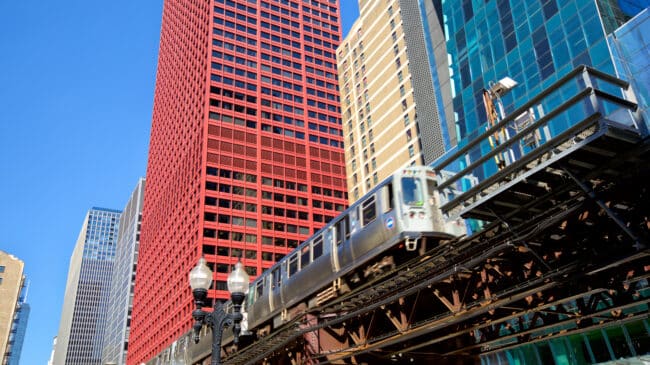The COVID-19 pandemic profoundly affected transportation demand across the country, especially in urban areas where mass ridership is still far below 2019 or pre-pandemic levels. With a fiscal cliff approaching for most transit systems, many local governments and agencies are scrambling for solutions.
The transit ridership recovery has varied drastically from metro area to metro area and even more from mode to mode. Transit ridership decreased from 802 million trips in January 2020, before the pandemic, to 158 million trips in May 2020, as most states were shut down. That’s an 80.3% decrease in transit ridership. Today’s transit ridership has somewhat bounced back but is still 38.3% below 2019 levels.
This piece explores two metro areas: Chicago, largely developed around pedestrians, horses, and streetcars pre-World War II, and Dallas-Fort Worth, which has grown and developed around the automobile after World War II. These cities illustrate the changes caused by the pandemic and the ongoing challenges facing transit agencies.

The Dallas region has multiple transit providers. Dallas Area Rapid Transit (DART) serves the most riders, followed by Fort Worth Transportation Authority (FWTA), followed by transit services operated or contracted out (to Via, a ridesharing service) by the city of Arlington, and STAR Transit, a public bus transportation service that operates in Kaufman, Rockwell, Mesquite, Balch Springs, Seagoville, Hutchins, and DeSoto counties.
DART operates the only light-rail options in the Dallas metro area. Ridership fell from 2.3 million riders in January 2020 to 975,072 riders in April 2020. By January 2023, ridership was 1.55 million, or 67% of its pre-COVID total. Meanwhile, bus lines only recovered 1.75 million riders, 57% of the 3.1 million riders they had in January 2020 before the pandemic.
One DART transit option has increased ridership in the Dallas metro area since the onset of the pandemic—demand-response services such as GoLink, which DART describes as: “Using a variety of vehicles and providers, GoLink provides curb-to-curb service within a designated zone —all on your schedule. Your ride comes to you!”
GoLink became more popular when it partnered with Uber to provide robust and flexible transit routes for riders in its service area. Ridership for demand-response services in the Dallas-Fort Worth area increased from 159,762 riders pre-pandemic to 189,365 in 2023, an 18.5% increase.
These services may help account for some of the region’s recovery in other transit modes because demand-response works well as a complementary service, connecting riders to transit stations they’d otherwise be unable to reach.
The Chicago Transit Authority (CTA) is the transit agency serving the most customers in the Chicago metro area, operating almost entirely within Chicago’s city limits. The latest ridership release from the Federal Transit Administration (FTA) shows that CTA only had 19.9 million riders in January 2023, just 54% of CTA’s pre-pandemic ridership of 36.6 million in January 2020.
CTA’s ridership recovery has differed heavily between modes. Rail ridership was 8.2 million in January 2023, 48% of its pre-pandemic total of 17.1 million. But bus ridership had recovered slightly more—60% of its pre-pandemic total—serving 11.7 million riders in January 2023 compared to 19.5 million riders in January 2020.
Pace, which serves the suburban parts of Chicago’s metro area, has only recovered 49% of bus ridership. But Pace’s on-demand service has recovered 70% of its riders. But much of Pace’s ridership is in flux, given its discontinuation of 69 routes.
The third major transit provider in the Chicago metro area is the Northeast Illinois Regional Commuter Railroad Company, colloquially called Metra. The FTA report for January 2023 shows that only 2.2 million riders had returned to Metra, compared to the 5.2 million who used their rail service in January 2020, or a 43% ridership recovery rate.
While there are myriad possible explanations why rail is recovering more slowly, a key consideration should be its relative inflexibility. Many workers who started to work remotely during the COVID-19 pandemic are still working from home or only going to the office a couple of days per week. Thus, many commuters have less need for a fixed-route transit service toward a central business district.
Despite this, Chicago has pointed to a lack of rail funding (despite receiving $3.54 billion in federal aid during the pandemic). CTA pledged to recruit and hire new drivers and went on a “listening tour” to better learn the concerns keeping riders away. But by setting up these listening tours at transit stations, they’re likely to get feedback primarily from users already using the transit system instead of those who have stopped using it or potential new riders.
Regional policymakers looking to encourage transit ridership should refocus on first learning why each mode is recovering slower or faster than expected, then on finding tailored solutions to adapt to the post-pandemic reality that many workers are staying home.
Matching the current demand for flexible transit services in a metro built for cars, like Dallas, can be easier to facilitate, especially with forward-thinking decisions like partnering with the private sector to provide service and linking to other transit services.
For various reasons, older metro areas like Chicago may struggle to emulate that success. For example, Chicago’s roads are nearly three times as congested as those in Dallas. Chicago ranks as having the most congested roadways in the country, according to the Jan. 2023 INRIX Global Traffic Scorecard.
Metro areas like Chicago can focus on improving existing transit options, like higher standards of cleanliness onboard transit options, more focus on rider safety on the L train, and combating issues like fare evasion, which further reduces the funding local governments have to provide transit services.
Overall, metro areas need to examine what transit demands are being unmet and try to tailor solutions to fit people reliant upon transit. As more people work and shop from home, transit systems must continue to adapt.

